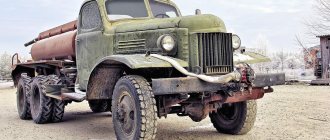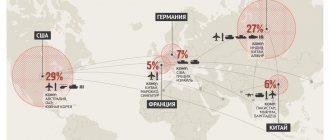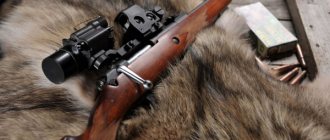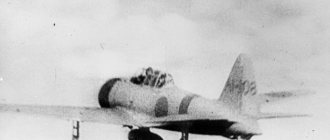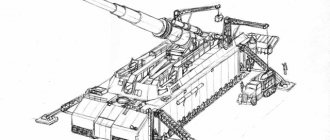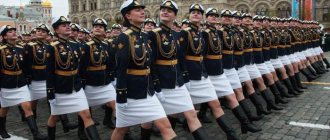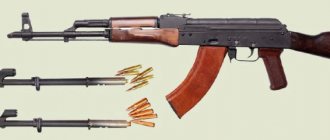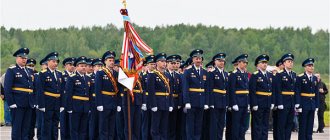The Russian Federation, as the legal successor of the collapsed Soviet Union, is today considered by many European states as a potential adversary. Therefore, when creating military doctrines, the emphasis is on possible military confrontation. The doctrine of the United States of America is somewhat different. According to experts, of all states, it is the United States that strives for global domination. The Russian Federation is forced to respond symmetrically. In this regard, it is quite understandable why many compare the military equipment of the United States and Russia. According to experts, the military potential of the two states is not inferior to each other. Information about Russian weapons and military equipment is contained in the article.
Acquaintance
The formation of the armed forces of the Russian Federation took place in 1992. At that time, only 288,000 people were in the Armed Forces. Today the number has reached 1 million. According to experts, Russia’s military equipment is modern and very developed. The country has weapons of mass destruction and many nuclear stockpiles. According to experts, the Russian army does not use weapons brought from abroad. Everything necessary for the needs of the army is manufactured on the territory of the state. Gunsmiths and the defense industry are developing new military equipment in Russia. Today, the aircraft is equipped with the most modern weapons. Modernizing the army, the state had to spend more than 19 trillion rubles. Experts suggest that by 2022, samples of new military equipment from Russia will account for at least 70%.
First World War
The warring sides entered the First World War with rifles and horses. Just a few years later, completely new war techniques began to be used at the front - toxic substances, tanks, and aircraft for various purposes.
At the same time, means of combating new weapons began to appear - gas masks, anti-tank and anti-aircraft artillery.
As new types of weapons developed, tactics for their use were developed and perfected.
The First World War revealed to the world such types of equipment as are known today, such as high-power long-range artillery, anti-tank rifles, and various automatic weapons.
Motorized military equipment was widely developed during the First World War. In addition to the already mentioned tanks, armored vehicles with cannon and machine gun armament, built on truck chassis, began to be used.
During the First World War, early examples of engineering equipment appeared, such as, for example, machines for digging trenches. Such installations significantly accelerated the preparation of defensive lines.
About heavy weapons
According to experts, Russia is four times superior to the United States in the production of self-propelled artillery multiple launch rocket systems. The Russian army has weapons that have no analogues in Western countries and, according to experts, will not appear in the near future. For example, the Russian Federation has the Solntsepek heavy flamethrower system and the Tornado multiple rocket launcher system. In Russia, the names given to military equipment are quite original. For example, in Great Britain a self-propelled artillery unit is listed as “Archer”, an American howitzer is listed as “Paladin”. In Russia, the flower names used for self-propelled howitzers, mortars and cannons are: “Carnation”, “Acacia”, “Tulip”, “Hyacinth”, “Peony”. The names “Malyutka” and “Chrysanthemum” were used for the 9M14M and 9M123 anti-tank missiles.
"Voevoda"
The main defense of the state is provided by nuclear strategic weapons. It is represented by a whole complex of ammunition, carriers, control systems and vehicles. This weapon uses nuclear energy, which is produced by fission and fusion of nuclei. Today, the RS-24 Yars is considered the new Russian nuclear weapon.
They began to create it back in the years of the Soviet Union, after the collapse of which Russia became the owner of all design developments. Nuclear complexes are assembled by workers at the Votkinsk Machine-Building Plant. The missiles were deployed in 2009. Soon, on the basis of Yars, engineers created a similar complex, which is known as Topol-M.
Collapse of the USSR
After the collapse of the Soviet Union, a fairly long period of stagnation began in the development of weapons and the army.
The troops of Russia and the CIS countries were content with the remnants of military equipment of the USSR, which remained in large quantities in various warehouses. But the existing weapons fleet quickly became outdated and, without a stable supply of spare parts for military equipment, broke down.
Almost 10 years and two bloody wars in Chechnya had to pass before the need to modernize the army was realized.
Since the beginning of the 2000s, active decommissioning of military equipment that has exhausted its service life and the supply of new equipment, which was manufactured anew or came from long-term storage bases, began.
PAK-FA T-50
It is a fifth generation multirole fighter. New Russian military equipment has been developed at the Sukhoi Design Bureau. The aircraft crew consists of one pilot. The length of the fighter is 19.7 m. Height is 4.8 m. The aircraft weighs 18,500 kg. The rate of climb is 330 m/s. For a take-off run, the T-50 needs at least 350 m. The flight range ranges from 4300 to 5500 km. The fighter is designed for a maximum combat load of up to 9400 kg. It rises to a height of up to 20 thousand km. The flight duration does not exceed 5.8 hours.
Structure of the Armed Forces of the Russian Federation.
The Russian army organizationally consists of three types of armed forces, two separate branches of the military. By type, these are the Ground Forces, the Aerospace Forces and the Navy. The branches of the military are the Airborne Forces (Airborne Forces) and the Strategic Missile Forces (Strategic Missile Forces).
The ground forces include:
- Motorized rifle troops.
- Tank forces.
- Rocket troops and artillery.
- Air defense troops.
- Intelligence units and military units.
- Corps of Engineers.
- Radiation, chemical and biological defense troops.
- Signal Corps.
Aerospace forces consist of the air force, space forces and air defense and missile defense forces. The Navy includes:
- Coastal troops.
- Surface forces.
- Submarine forces.
- Naval aviation.
- Fleet unification.
According to the territorial principle, the Russian army is divided into military districts (Western, Southern, Central and Eastern) and the Northern Fleet Joint Strategic Command.
Military districts.
Tu-160
It is a strategic supersonic missile carrier-bomber. Military equipment was developed in Russia by employees of the Tupolev experimental design bureau. The plane's crew consists of 4 people. The Tu-160 weighs 118 thousand kg. The aircraft model is designed for a maximum combat load of up to 40 thousand kg. The combat load does not exceed 9 thousand kg. The plane moves at a maximum speed of 2200 and a cruising speed of 850 km/h. For the take-off run of the Tu-160, 2 thousand meters are required. The time spent in the air is limited to 15 hours. Bomber without built-in weapons. Used to transport thermonuclear and conventional bombs, min.
Aviation
The armament of the Russian Army in terms of aviation allows it to provide protection and attack on the enemy, as well as carry out various operations, such as reconnaissance, security and others. Aviation is represented by airplanes and helicopters for various purposes.
Among the aircraft, it is worth noting the Su-35S model. This fighter is multifunctional and highly maneuverable; it is designed to strike moving and stationary ground targets. But its main task is to gain air supremacy. The Su-35S has engines with higher thrust and a rotary thrust vector (product 117-S). It uses fundamentally new on-board equipment - the aircraft’s information and control system ensures the maximum degree of interaction between the pilots and the aircraft. The fighter is equipped with the latest Irbis-E weapons control system. It is capable of simultaneously detecting up to 30 air targets, firing at up to 8 targets without interrupting observation of ground and air space.
Among helicopters, the KA-50 “Black Shark” is the modern weapon of the Russian army. These two combat vehicles are formidable weapons; so far no country in the world has been able to create and oppose equipment that matches them in terms of tactical and technical capabilities. "Alligator" can operate at any time of the day or night, under any weather and climatic conditions. The “Black Shark” is designed to destroy various armored vehicles, including tanks, as well as to provide protection for ground facilities and troops from enemy attacks.
T-14 "Armata"
This example of Russian military equipment is the main tank. Produced in the design bureau of UralVagonZavod. The tank has a crew of three people. The combat weight of one combat unit is 57 thousand kg. The tank is equipped with a 12-cylinder X-shaped diesel turbopiston engine A-85-3A. In order to save the engine life of the Almata, the power of the power plant was increased from 1500 hp. lowered to 1200. On a flat surface, the T-14 is capable of moving at a speed of 70 km/h. "Armata" is armed with a 125 mm 2A82 smoothbore gun. Guided missiles are used as projectiles.
In addition, this Russian military equipment is equipped with one 7.62 mm modernized Kalashnikov tank machine gun and one Kord machine gun of 12.7 mm caliber as additional weapons. Primary and secondary weapons with remote digital control. The gun has 45 shells. Of these, 32 are located in the charging machine. The ammunition for the Kalashnikov machine gun consists of 2 thousand rounds. Of these, 1 thousand are in combat readiness. Another thousand are located in special belts. There are 300 rounds of ammunition available for the Kord. They are kept in boxes. Charging is performed automatically. The Armata can detect a target at a distance of 5 thousand meters. The destruction is carried out at a distance of up to 7 thousand meters. The tank uses a universal tracked platform, the creation of which uses the best practices of such models as the Black Eagle and T-95. The unique feature of "Armata" is the presence of an uninhabited tower. In the manufacture of the armor, high-quality steel 44S-SV-Sh and additional ceramic and composite layers were used.
Grenade launchers in Russian troops
Grenade launchers are designed for various purposes and are divided into several types. Thus, they distinguish easel, automatic, manual, multi-purpose, under-barrel and remote-controlled. Depending on the type, they are intended to destroy enemy troops, moving and stationary targets, and to destroy unarmored, lightly armored and armored vehicles.
New small arms of the Russian army in this category are represented by the RPG-30 “Hook” grenade launcher. It is a disposable weapon and entered service with the troops in 2013. The anti-tank system is double-barreled and contains two grenades: an simulator and a 105-mm combat grenade. The simulator ensures the activation of the enemy’s defense functions, and the combat grenade directly destroys the target that remains unprotected.
We cannot ignore such modern weapons of the Russian army as the GP-25 and GP-30 under-barrel grenade launchers. They are equipped with Kalashnikov assault rifles of the AK-12, AKM, AKMS, AKS-74U, AK-74, AK-74M, AK-103 and AK-101 modifications. The GP-25 and GP-30 underbarrel grenade launchers are designed to destroy living and non-living targets and unarmored vehicles. The target firing range is about 400 m, the caliber is 40 mm.
About the T-72B tank
The Ural Carriage Works became the developer of military equipment in Russia. Design of the tank began in 1985. The crew of the combat transport unit consists of three people. The tank weighs 42.5 tons. T-72B with ballistic combined armor. In addition, the equipment is equipped with mounted dynamic protection. Equipped with a 125 mm 2A46M cannon. The function of additional weapons is performed by a Kalashnikov tank machine gun and an anti-aircraft NSVT of 7.62 and 12.7 mm calibers.
In addition, the T-72B is equipped with the 9K120 Svir complex, which fires anti-tank guided missiles. The maximum firing range from the main gun is 4 thousand m. The projectile weighs no more than 23 kg. The combat set of the main gun consists of 45, ATGM - 4 shells, Kalashnikov machine gun - 2 thousand rounds, NSVT - 300. The power unit is represented by a V-84-1 diesel engine with a power of 840 hp. On a flat surface the tank moves at a speed of 60 km/h. Rough terrain travels at 35 km/h. The T-72B is equipped with an R-173 radio station, an R-174 intercom, GPK-59 navigation equipment, a TDA smoke screen creation device, and a TKN-3V sighting system. In addition, the tank has fire-fighting equipment ZETS13 “Iney” and refrigerant cylinders. T-72B is a tank with katana and cast steel armor. The body is made by welding. Rolled armor parts of various thicknesses and designs are used in production.
Post-war conflicts
After 1945, the creation and development of new war technology began, which was created taking into account the emerging nuclear weapons. All samples of tracked and wheeled vehicles were created taking into account possible action in conditions of contamination of the area with radioactive decay products.
For this purpose, various filtering devices were used to prevent radioactive dust from entering the machines. The first direct competition between military equipment of the USSR and the USA was the Korean War.
During this conflict, jet fighters of the latest models at that time - the MiG-15 and Saber - were massively used. During the Vietnam War, the brainchild of the American and Soviet design schools met again in the sky.
A little later, many famous examples of Soviet military equipment appeared - the T-55, T-62 and T-80 tanks. These vehicles were supplied to the armed forces of many countries and are still in service today. Another symbol of military conflicts of the second half of the 20th century was the Kalashnikov assault rifle.
The experience of operating US military equipment had a great influence on the development of the post-war industry of the USSR.
This was especially pronounced in the automotive industry. The experience of using Studebaker US6 army vehicles has shown the urgent need to create similar wheeled vehicles of domestic production.
Such vehicles under the designation ZiS-151 appeared immediately after the Second World War. Gradually, this technique began to be used in the civil service. Based on existing developments, Soviet designers were able to create a number of unique off-road army vehicles - GAZ-66 and ZIL-131.
In terms of cross-country ability, these vehicles will leave many developments of that time far behind. However, the price for such characteristics is a complete lack of comfort in the cabin.
Another important legacy of Lend-Lease was the two-stroke diesel engines that began to be equipped with post-war YAZ-200/210 (and later MAZ) trucks.
Initially, the American diesel GM was created to equip light army equipment. Domestic motors remained in production until the end of the 80s and were used to drive various mobile power plants.
5P85S
It is a launcher equipped with the S-300PS complex. The preparation and launch of the missiles is provided by a special container, autonomous power supply - the 5S18A system. The combat crew consists of four people. The fire is carried out by 5V55R anti-aircraft guided missiles. The ammunition load includes 4 shells. It takes 5 minutes to deploy the complex. The target is destroyed at a range of 47 thousand meters at an altitude of up to 2 km. The maximum flight altitude of the rocket is 30 km. The projectile flies at a speed of 1.2 m/s. When arranging the chassis, the MAZ-54ZM chassis was used. The complex is capable of reaching a maximum speed of up to 60 km/h.
Vehicles
The Russian army is equipped with vehicles for various purposes on a large scale. Automotive vehicles are presented in the form of highly mobile, cargo-passenger, multi-purpose, specially protected and armored vehicles.
The Tiger STS, which was adopted by the Russian army, has proven itself especially well. The vehicle is used for reconnaissance operations, monitoring the enemy, transporting personnel and ammunition, patrolling high-risk areas, and escorting mobile columns. It has high maneuverability, a large range, and good visibility for firing.
For the rapid transfer of equipment, ammunition and personnel in large quantities, the KRAZ-5233BE “Spetsnaz” is used. The vehicle is designed for work in harsh climatic conditions (from – 50 to + 60 degrees), has high cross-country ability – it can overcome water obstacles up to 1.5 m deep and snow covers up to 60 cm high.
A-222 "Bereg"
The military equipment is a 130-mm artillery mount. The crew size is 8 people. The weight exceeds 43 tons. The installation is equipped with a D-12A-525A diesel engine with a power of 525 horsepower. On a flat surface, the equipment moves at a maximum speed of 60 km/h. The installation was equipped with one 130 mm caliber gun. It is fired at a target located no further than 23 thousand meters. The barrel has a muzzle brake and an ejector. Military equipment is equipped with 48 F-44 high-explosive shells. One ammunition weighs 33.4 kg. It moves towards the target at a speed of 850 km/h. Within one minute, 14 shots can be fired from the complex. The task of this military equipment is to provide defense on the coast. The crew of the A-222 Bereg fires at enemy ships, aircraft and cruise missiles. In addition to the self-propelled guns, the complex includes the BR-136 “Feed” management system and a duty combat vehicle. In the production of the A-222, the MAZ-543M chassis is used, the mass of which is 21 tons. The installation uses a ballistic computer, a laser range finder and an optical-electronic command sight, thanks to which, in the event of a breakdown of the BR-136 control system, fire is fired at the target automatically.
Early 20th century
The first wars of the new century brought machine guns into the battle arena and created a new type of military equipment - the mortar, which first appeared during the Russian-Japanese War. The Japanese design school introduced a new type of high-explosive shells with increased power, thanks to which they won all the naval battles of that war.
During the interwar period, new war technology was created with an eye on the experience of the past. It was the experience of naval battles of the Russo-Japanese War that led to the creation of a new type of battleship - dreadnoughts.
"Eagle"
It is a heavy aircraft-carrying cruiser, with a displacement from 55 thousand to 67,500 tons. It moves at a speed of 30 nautical knots. The cruiser is equipped with boilers (8 pcs.), GTZA (4 pcs.) and four propellers. The power of the power plant reaches 200 thousand liters. With. The crew size is 2590 people. The cruiser transports 626 aircraft units. "Eagle" is armed with 12 P-700 "Granit" launchers, "Dagger" (4 units) and "Kortik" (8 units) anti-aircraft missile systems. In addition, the cruiser has two Udav-1M RKPTZ, the ammunition load of which consists of RSL-120 (60 units), Su-33 (24 missiles) and Ka-27 (18 units).
On the conservation of military equipment in Russia
According to experts, there are classified strategic military bases on the territory of the country designed to store various units of military equipment: vehicles, mobile command posts, S-300 complexes, engineering and radar. For most combat units, MAZ and KRAZ wheelbases are used. Judging by the reviews, some of the equipment is quite worn out. However, there are models in the hangars that were sent for conservation after successful sea trials. If necessary, they are suitable for combat missions.

